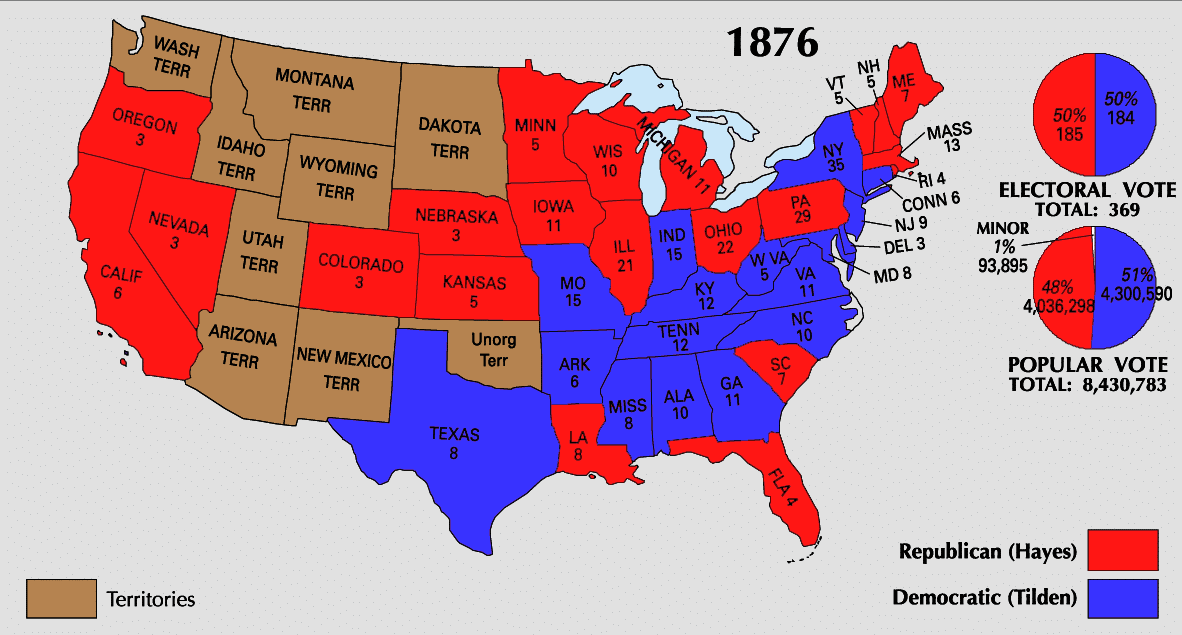The Presidential Election of 1876 remains one of the most controversial elections in American History.

President Ulysses S. Grant was considering a third run for President, which would break the tradition that had been set since George Washington had left office after the Election of 1800. He decided not to run.
Grant's administration had been rocked by scandals, but his popularity still remained strong with the public. With him out of the picture, the Democrats had a window to take the White House possibly.
The candidates are as follows:
- Republicans: Rutherford B. Hayes and Vice President William Wheeler
- Democrats: Samuel J. Tilden and Vice President Thomas A. Hendricks
Platforms
Republicans: The Republicans decided on Rutherford B. Hayes as their candidate late in the process. He had the distinction of serving in the Civil War and being popular in Ohio, which was a crucial swing state. He would carry on the same policies that Grant had implemented.
Democrats: The Democrats were beginning to emerge as a stronger party with fresh new ideas. After 8 years of unbridled corruption under Grant, the Democrats began to push for civic reform and more accountability. Tilden was a well-known and able leader as he had prosecuted and imprisoned legendary crime boss William M. Tweed.
The Presidential Election of 1876 would also see many political parties participate. While their ability to make a dent on the national stage was minimal, their ideas would begin to influence the other parties. These ideas included Women's Suffrage, Prohibition, and opposition to monopolies.
Outcome
This would be one of the most controversial outcomes in American History.
The South, under the influence of the Klu Klux Klan and other racist groups, intimidated Republican voters, especially African-Americans. There was fraud throughout many states.
In Florida (with 4 electoral votes), Louisiana (with 8), and South Carolina (with 7), reported returns favored Tilden, but election results in each state were marked by fraud and threats of violence against Republican voters.
The worst case was in South Carolina, where an impossible 101 percent of all eligible voters in the state had their votes counted. One of the points of contention revolved around the design of ballots. At the time, parties would print ballots or "tickets" to enable voters to support them in the open ballots.
To aid illiterate voters, the parties would print symbols on the tickets. In this election, many Democratic ballots were printed with the Republican symbol, Abraham Lincoln, on them.
The Republican-dominated state electoral commissions subsequently disallowed enough Democratic votes to award their electoral votes to Hayes.
Similar issues occurred in Oregon.
In the end, Hayes seemed to have the majority of electoral votes but not enough to win the election. Democrats cried fraud, and a shot was even fired at Hayes at his home in Columbus, Ohio.
There were threats of violence against Republicans throughout the country. Meanwhile, President Grant began building up the army.
Facing an unprecedented constitutional crisis, the Congress of the United States passed a law on January 29, 1877, that formed a 15-member Electoral Commission to settle the result. Five members were selected from each house of Congress, and they were joined by five members of the Supreme Court.
William M. Evarts served as counsel for the Republican Party. The Compromise of 1877 might have helped the Democrats accept this electoral commission as well.
To settle the stalemate, the two parties agreed to the Compromise of 1877. The compromise would allow Hayes to become president and would withdraw federal troops from the South and thus end Reconstruction.
